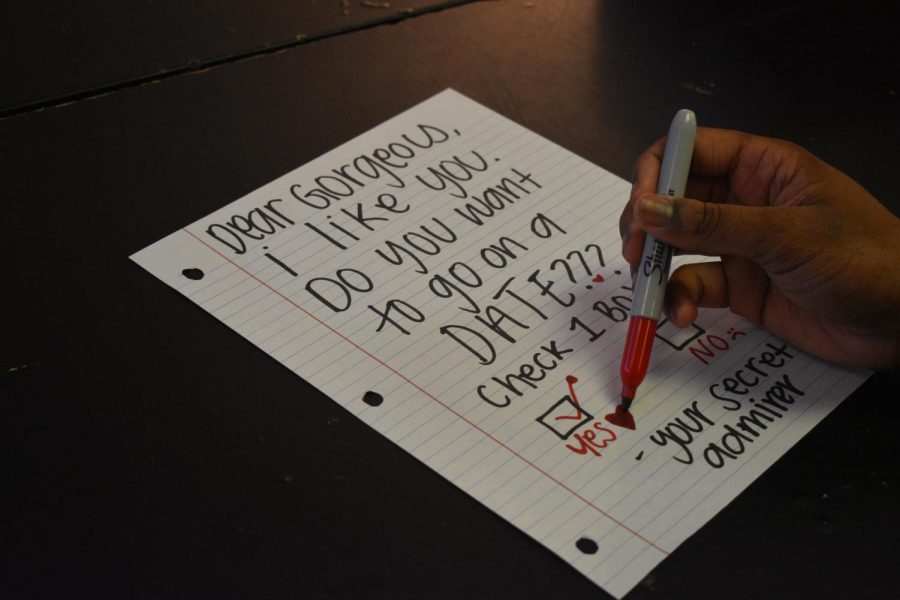Hope for high-school-sweethearts: the modern teenage view of commitment
Young love: regardless of its negative interpretation in media, or the discouraging attitude adults tend to carry toward it, the romance between teenagers lies as a pivotal experience for people yet to have driven legally. While a lack of maturity plagues society’s notions of adolescent relationships, teens prove that through valuing the sweet moments, their love remains intact.
May 16, 2023
Romance: a seven-letter word that dictates several facets of the adolescent experience. Through first kisses, first bases and first break-ups, finding love stands as the premiere accomplishment for high schoolers before they receive their diplomas. When it comes to dating, however, navigating that sector of love’s terrain can become daunting for the average student attempting to pass calculus. In an age where hook-up culture dominates heartfelt connections and technology delivers relationship statuses through the World Wide Web, the culture around teenage dating feels disingenuous. Nevertheless, hope still stands for those young people in search of that special person or people, depending on their preferences. While maturity and societal expectations of adolescent love may taint its image, the willingness of teenagers to commit to long-term relationships in high school increasingly appears as a possibility.
Historically, teenage love receives a negative reputation in American media and storytelling. In shows centered around high schoolers in relationships, miscommunication runs rampant, painting the picture that those under 18 can not clearly express their feelings. While several shows reign notorious for their dramatic confessions of love or lust within their main couples, those diatribes do not stand as practical. Where Hollywood’s teenage characters enjoy the small-town pining featured in Gilmore Girls, or the uber-rich and awkward confessions of The OC‘s cast, open communication between partners keeps the connections of the real world running. According to Randi Gunther PhD. in Psychology Today, communication ranks fourth on her list of nine important aspects of working relationships. She regards the act of open expression as integral to the flow between partners, thus allowing them the space for understanding. For teenagers fully committed to maintaining a relationship’s integrity, communication does not appear as a chore; instead, it allows partners the strength to rely on one another in the face of potential issues, such as needing space.
Long-distance relationships (LDRs) maintain a stronghold in society’s lexicon of dating. Upon typing the term into a search bar, the unsuspecting Googler falls prey to a plethora of articles detailing ways to sustain LDRs and unsolicited advice on how to maintain its strength. When high school ends, however, teens find themselves in a potential predicament: figuring out how to keep a high school union steady. While several blogs promote manners in which LDRs could last, the same attitude of hope seems to disappear when teenagers come into the equation. These young liaisons receive immediate distaste or condolences from older audiences, usually followed by claims that the parties involved do not possess the proper levels of maturity to last in college or beyond. Despite preconceived notions, however, teenage relationships can prove that distance does not mean destruction. If couples decide to put in the work to keep their union strong, teenagers in love can find solace in trusting each other, no matter the miles between them.
“There were definitely some challenges with the long distance while my husband— then, boyfriend—was a freshman in college and I was a senior in high school. However, we were so busy because those are both pivotal years and this made the year go by really fast. I was trying to enjoy my last year of high school with friends that were moving all over the place for college, and he was trying to make friends and adjust to being on his own in college. This helped pass the time until we were both at Auburn [University] together. Fortunately, we were able to talk on the phone frequently and were only 2 hours away so we could visit each other fairly easily as well,” 9th-grade literature teacher and Gifted Coordinator Laura Smith said.
Regardless of age, the depth of any relationship relies on a person’s ability to value the sweet moments with their significant other. When distance or communication may falter, through valuing tender and vulnerable moments, couples find themselves tackling strains together, even if they reside physically apart. For long-distance unions, apps such as Zoom or Skype that provide video-chat services allow couples to connect with one another. For a retro-esque feel, couples could also send each other letters or care packages with gifts or photos from when they last saw one another to increase the anticipation of seeing each other again.
This same sentiment extends to couples who see each other in person every day. In an age where social media stands as the judge, jury and executioner for relationships, young couples can find solace through the act of privacy. The trend of soft-launching— when couples covertly post their significant others at the beginning of a relationship— allows people agency in their unions when they start out. To combat the adolescent stereotype of lusting over a loved one’s partner, young couples may also attend dates or events with one another to build a bond that transcends physical needs. Acts such as remembering their partner’s favorite treats and purchasing them, or creating playlists that express one’s love through lyrics can also fuel the sweetness of a relationship. If young people commit to valuing those wholesome moments, the relationship feels increasingly genuine.
However, while teenagers may own the faculties to sustain a satisfying relationship, a lack of commitment may stand as an obstacle before teens fully commit to one another. According to an article by Carl E Pickhardt Ph.D. titled “Adolescence and Commitment,” he states that the primary reason why teenagers refrain from commitment stands as not wanting disappointment. Despite this, Pickhardt acknowledges the inevitability of disappointment and how that risk may still lead to a reward. If teens believe in the potential success of a relationship and create trust between themselves and their partners, commitment can naturally grow. The only way a committed relationship will blossom stems from a mutual understanding between all parties to keep it together.
“I do not think many teenagers undreamt what level of commitment they need in order for a relationship to be successful, it is often said that each person has to give 50% so they are a 100% together but [a] commitment to someone else is giving 100%, and when you are unable to give 100%, you give what you can and the other person help you with the rest. It is always being there for the other person to help them through the good and bad and not leaving when times are hard or disagreements are abundant,” magnet sophomore Charles Klock said.







